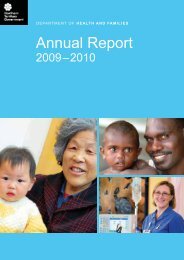PCD Strategy Evaluation 2007.pdf - NT Health Digital Library ...
PCD Strategy Evaluation 2007.pdf - NT Health Digital Library ...
PCD Strategy Evaluation 2007.pdf - NT Health Digital Library ...
You also want an ePaper? Increase the reach of your titles
YUMPU automatically turns print PDFs into web optimized ePapers that Google loves.
Priority funding for <strong>PCD</strong>S implementationA strength of the current <strong>PCD</strong>S is that it allows governments to fund new programs as they arisewhen the chronic disease services case has been already clearly spelt out in the <strong>PCD</strong>S <strong>Strategy</strong>.For example: cardiac rehabilitation – offered through <strong>Health</strong>y Living <strong>NT</strong> – began as a project withthe Divisions of General Practice. However it was eventually funded from the <strong>NT</strong> budget becauseit was a best buy of <strong>PCD</strong>S. At the Departmental level, the S100 funding of the <strong>PCD</strong> Program wassupplemented by rolling a number of other existing positions into the program including „TotalRecall‟ nurses.Assessment against objectiveCurrently only a minority of areas are funded using the <strong>Health</strong> Zone model, and the actualbenefits of this for chronic disease have not been clearly demonstrated. This model of careappears administratively complex, and implies the involvement of an increased number ofdecision-making bodies in chronic disease care.Many projects addressing chronic disease paradoxically suffer from short timelines in which theyare funded to operate and a lack of funds to arrange follow up. For example, in June 2004,<strong>Health</strong>y Living <strong>NT</strong> received funding from <strong>NT</strong>DH&CS out of unspent S100 money to provideeducation and training to selected non-government health clinics throughout the NorthernTerritory. This program was only conducted until December 2004 (39) . During this time, theyarranged for cardiac and diabetes educators to visit 11 non-government health services acrossthe <strong>NT</strong>. A total of 40 health professional staff, and 48 clients, received diabetes and cardiaceducation in education sessions ranging from one to three hours duration. Both clients and staffregarded these education sessions positively.In another example, in 2003 the Darwin Diabetes and Education Resource Centre for <strong>Health</strong>yLiving <strong>NT</strong> received a $60,000 NDIP Grant from the Department of <strong>Health</strong> and Ageing to employan Aboriginal <strong>Health</strong> Worker to identify barriers in access to diabetes education for urbanIndigenous people in the Darwin area. This project commenced in October 2003 but wascompleted in July 2004, and produced exceptional results. Where before 2003, the Darwin officesof Diabetes Australia <strong>NT</strong> had seen few Aboriginal people, by early 2004 this situation hadchanged considerably and they reported seeing between 34 and 66 Aboriginal and Torres StraitIslander people per month. Unfortunately, this fell back to between 1 and 4 Indigenous peopleper month for the last few months of the year after the program stopped (71) .Chapter 3: Progress Against <strong>PCD</strong>S Objectives – <strong>Evaluation</strong> of the <strong>NT</strong> Preventable Chronic Disease <strong>Strategy</strong> 2007 72
















